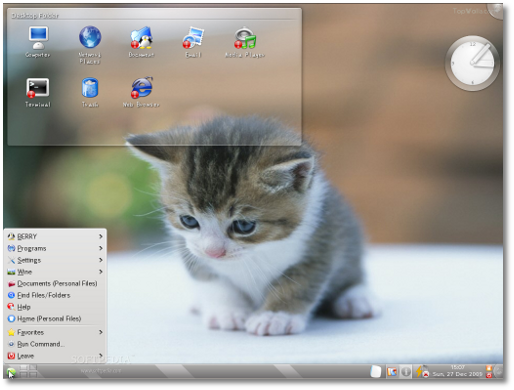Yuichiro Nakada proudly announced on the first day of Christmas that his Linux distribution finally reached version 1.00. Berry Linux 1.00 is now powered by the Linux kernel 2.6.32.1 and based on the Fedora 11 operating system. The new release of Berry Linux updates a few important packages, such as the latest version of Mozilla Firefox, MPlayer, Wine, and last but not least, it is built on top of the KDE Software Compilation 4.3.2, which is now in sync with the version from Fedora 11.
Highlights of Berry Linux 1.00:
· Based on Fedora 11; · Kernel 2.6.32.1 SMP (with ndev/udev and bootsplash); · AUFS 20090921; · Removed madwifi r4100; · KDE 4.3.2; · Rasp-UI 0.14 (Window Manager); · MPlayer 20091211; · Xine 0.99.5; · xine-lib 1.1.17; · Mozilla Firefox 3.5.6 (in both Japanese and English); · Wine 1.1.32.
Why should I use Berry Linux? Because:· Berry Linux can boot from USB sticks; · Berry Linux uses WHIZ, a very sharp Kana-Kanji conversion system; · Automatically recognizes USB storage and shows icons; · Berry Linux uses free Japanese True Type Fonts; · Berry Linux uses bootsplash when booting; · Berry Linux uses DHCP to connect to the Internet (PPPoE is also available); · Berry Linux can save personal setting in Live mode; · Berry Linux is Red Hat/Fedora compatible.
Berry Linux is a Live CD Linux distribution based on the famous Fedora OS. It offers automatic hardware detection and support for many sound cards, graphics cards, USB & SCSI devices, and various other peripherals. It includes the Mozilla Firefox web browser, OpenOffice.org office suite, Wine and many other Microsoft Windows compatible applications. Because it's a Live CD, it can be used as an Educational CD, a rescue system CD or just as a Demo CD to showcase the powers of Linux to your friends, family and colleagues.
Download Berry Linux 1.00 right now from Softpedia.

 14 DAY TRIAL //
14 DAY TRIAL // 